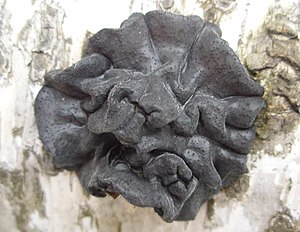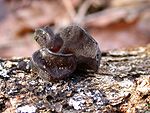Warty glandular
| Warty glandular | ||||||||||||
|---|---|---|---|---|---|---|---|---|---|---|---|---|

Warty glandlet ( Exidia nigricans ) |
||||||||||||
| Systematics | ||||||||||||
|
||||||||||||
| Scientific name | ||||||||||||
| Exidia nigricans | ||||||||||||
| ( With. ) P. Roberts |
The warty glandular ( Exidia nigricans , syn. E. glandulosa ss. Fries, E. plana ) is a type of fungus from the family of the ear flap relatives (Auriculariaceae). It is a common, wood-decomposing species in the northern hemisphere, which typically grows on dead branches of deciduous trees that are still in place . It is often confused with the stubble gland ( E. glandulosa ss. Orig, E. truncata ) and the tar-spot gland ( E. pithya ).
features
Macroscopic features
The dark sepia-colored to blackish fruit bodies have a rubbery-gelatinous consistency. Initially growing in spherical groups, they soon flow together to form a continuous layer that lies flat against the substrate and is up to 30 × 5–6 cm in size and 5 × 20 mm thick. The warty glandle has an irregular, brain-like, bulging and furrowed structure. The greasy, shiny surface is covered with small glandular papillae, sometimes only visible with a magnifying glass. Dried fruit bodies form a thin, black crust and swell back to their original size when damp. The spore powder is white.
Microscopic features
The elliptical, transversely septate basidia measure 15–25 × 8–13 micrometers. Sausage-shaped and 14–19 × 4.5–5.5 µm large spores mature on them. They are colorless, smooth and show no color reaction in iodine solution . Conidia are also formed.
Species delimitation
The warty and stubble glandular ( Exidia glandulosa ) are often confused. The two are similar, but the Stubble Drüsling produces separate, peak-shaped fruiting bodies that rarely grow together, if at all. They cannot be distinguished microscopically, but DNA studies show the difference.
The tar-spot glandle ( Exidia pithya ), which is sometimes only regarded as a variation, occurs only in coniferous wood and the surfaces of its smaller, flatter and smoother fruiting bodies show only a few warts.
The sheet-like jitter Ling ( Tremella foliacea ) usually has but a warmer, lighter brown can sometimes dark sepia be to black. Its fruiting bodies are gelatinous, but usually leafy (with flat lobes or fronds) and never have warts or pimples on the surface. It is common and appears on both deciduous and coniferous trees .
Ecology and diffusion
The wood-decomposing ( white rot ) Warty Drüsling lives as a saprobiont on and in the dead wood of deciduous trees. Typically in a wide range of deciduous trees (rarely also in coniferous wood) it lives in dead branches and trunk parts that are still on the standing tree and lives in them for a while after falling. It is fruitful all year round, with a focus on late autumn.
The species is widespread in the northern hemisphere, including North America and Europe.
meaning
At least there is no poisonous effect against use for food purposes.
Systematics and taxonomy
The species was originally described by William Withering in England in 1776 as Tremella nigricans , based on a name published by Johann Jacob Dillen in 1741 . It was later regarded as a synonym for Exidia glandulosa until Marinus Anton Donk revised the species conceptions in 1966 and classified it as synonymous with Exidia plana . Changes to the official introduction date of the scientific mushroom nomenclature made Exidia plana inadmissible, but leave Exidia nigricans as the oldest name of the species.
Molecular studies have shown that stubble and warty glandular are different species despite being similar.
The Latin epithet "nigricans" means "blackish", "dark". The epithet “ plana ” from the outdated scientific name is a reference to the flat spread of its fruiting body structures (Latin “ plana ”: “flat”).
Common names
The warty Drüsling is also ambiguously referred to as " witch butter ". Also in English there is the term "Witches' butter" (German "Hexenbutter") as a species name, but this name is used after the 18th century as in German for other tremellomycetes such as the Stubble Drüsling and the golden yellow trembling ( Tremella mesenterica ) . The name can be traced back to an old popular belief that witches milk cows at night and use the milk to produce this unappetizing butter, which they then distribute to their nightly meeting places. In Sweden, the species is known as “Troll smör” (“Troll butter”) for the same reason.
swell
- ^ A b c Josef Breitenbach, Fred Kränzlin: Fungi of Switzerland . A Contribution to the Knowledge of the Fungal Flora of Switzerland. Non gilled fundi, Heterobasidiomycetes (jelly fungi), Aphyllophorales (non-gilled fungi), Gasteromycetes (puffballs). tape 2 . Richmond Publishing Co. Ltd., 1986, ISBN 978-3-85604-220-2 , pp. 65–66 (Original title: Pilze der Schweiz 2 - non-leaf mushrooms: Heterobasidiomycetes, Aphyllophorales, Gastromycetes . Translated by Virginia L. Waters, James F. Waters, as Exidia glandulosa ).
- ↑ a b Michael Weiß, Franz Oberwinkler: Phylogenetic relationships in Auriculariales and related groups - hypotheses derived from nuclear ribosomal DNA sequences . In: British Mycological Society (Ed.): Mycological Research . tape 105 , no. 4 , 2001, p. 403-415 , doi : 10.1017 / S095375620100363X (English).
- ↑ a b c d Fredi Kasparek: Gelatinous mushrooms . In: Karin Montag (Ed.): The Tintling - The Pilzzeitung . No. 31 , June 2002, p. 16-23 ( tintling.com [PDF]).
- ↑ a b c Hans E. Laux: The great cosmos mushroom guide. All edible mushrooms with their poisonous doppelgangers. Franckh-Kosmos, Stuttgart 2001, ISBN 3-440-08457-4 , p. 588.
- ^ MA Donk: Check list of European hymenomycetous heterobasidiae . In: Nationaal Herbarium Nederland & Centraalbureau voor Schimmelcultures (ed.): Persoonia - Molecular Phylogeny and Evolution of Fungi . tape 4 , 1966, pp. 145-335 (English).
- ↑ International Code of Botanical Nomenclature
- ↑ Peter Roberts: Exidia nigricans . a new and legitimate name for Exidia plana . In: Mycotaxon, Ltd. (Ed.): Mycotaxon . tape 109 , 2009, p. 219–220 , doi : 10.5248 / 109.219 (English).
- ^ Karl Ernst Georges: Comprehensive Latin-German concise dictionary . tape 2 . Hanover 1918, Sp. 1158 ( zeno.org ).
- ↑ Dillenius, 1741
- ^ Withering, 1776
- ^ RT Rolfe, FW Rolfe: The Romance of the Fungus World . An Account of Fungus Life in its Numerous Guises, both Real and Legendary. 1925, p. 13 (English).
